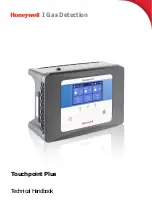
MAN0984_Iss 4_01/19
Touchpoint Plus
Pt. No. 3011M5001
11
Technical Handbook
1.5
TPPL General Cautions
1.6
How to Use this Manual
1.6.1
Intended Readers
This Manual should be read by everyone who operates or monitors the Touchpoint Plus gas detection system.
Only personnel who have been fully trained by Honeywell are authorised to Install, Set-up, Service, and Test, Repair, or
Recondition Honeywell gas detection systems.
1.6.2
Conventions Used
The following conventions are used in this manual:
Boot up
refers to the action of starting the software from cold.
Menu>Configuration>Channel
highlights a sequence of commands (including button touches).
mV Sensor
refers to a mV Bridge Sensor.
Reboot
refers to shutting down and restarting the software without interrupting the power supply.
Restart
refers to cycling the power off and then on again.
SELV
refers to Safety Extra-Low-Voltage devices.
[Start] highlights unique button touches.
Start up
refers to the action of switching on the system.
Touch
refers to all direct interactions with the Touchscreen, whether by finger or stylus.
TPPL
refers to the Touchpoint Plus Gas Detection System.
1)
Touchpoint Plus SMPS, Input and Output Modules have no user serviceable parts. In the unlikely event of a
failure, the item must be replaced using only manufacturer supplied parts.
2)
Do not use sharp objects to operate the Touchscreen as this could irreparably damage the User Interface
and adversely affect its IP rating.
3)
Use only soft, damp cloths or screen wipes to clean the Touchpoint Plus. Do not use solvents or abrasives
as they will cause irreparable damage.
4)
Once commissioned, Touchpoint Plus is intended for continuous operation.
5)
Undo the security screws before pulling the locking handle. Failing to do so may irreparably damage the
enclosure.
6)
Do not place any objects on top of the enclosures as this may cause overheating and may cause the
enclosure to fall from the wall.
IMPORTANT
Personnel, who work on, or in the area of, the Touchpoint Plus Gas detection system must be made aware of
the contents of Chapter 2 Safety Hazards, Warnings and Cautions.
Before unpacking the system, read carefully the accompanying documentation.












































